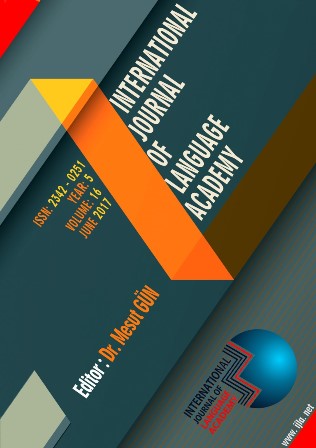ORHAN PAMUK'UN BEYAZ KALE ADLI ESERİNİN THE WHITE CASTLE BAŞLIKLI İNGİLİZCE ÇEVİRİSİNDE KÜLTÜREL ÖĞELERİN AKTARIMI ÜZERİNE BİR İNCELEME
Author :
Abstract
Dünya üzerinde birçok dil bulunması sebebiyle çeviriye olan ihtiyaç kaçınılmazdır. Çeviri sayesinde farklı toplumlar ve kültürler hakkında bilgi sahibi olunur. Bu yüzden çeviri ve kültür ayrılmaz bir ikilidir. Çeviri denilince ilk akla gelen alanlardan biri ise edebiyat çevirisidir. Edebiyat çevirileri estetik ve duygulara yönelik öğeler içerir ve bunları erek dile aktarmak oldukça zordur. Geçmişten günümüze birçok edebi eser Türkçeye çevrilmiştir. Son zamanlarda ise Türkçeden farklı dillere çevrilen eserlerin sayısında oldukça hızlı bir artış gözlemlenmektedir. Bu çalışmada, Orhan Pamuk’un Beyaz Kale adlı eserinin The White Castle adıyla İngilizceye çevirisinde geçen kültürel öğeler ve bu öğelerin İngilizceye çevrilmesinde kullanılan çeviri stratejileri incelenmiştir. Çalışma sonucunda, yazarın tek bir strateji kullanmak yerine farklı stratejilere başvurduğu gözlenmiştir. Bu stratejilerden en az kullanılanın silme/atma yöntemi olduğu tespit edilmiştir.
Keywords
Abstract
The need for translation is inevitable considering the fact that there are lots of languages in the world. By the help of translation, people obtain information about different societies and cultures. Therefore, translation and culture are inseparable. On the other hand, literary translation is one of the types of translation that comes to mind first. It involves aesthetic and emotional elements, and it is challenging to transfer them to the target language. From past to present, many foreign literary works have been translated into Turkish. Recently, there has been a considerable increase in the number of works translated from Turkish into different languages. In this study, the cultural elements in Beyaz Kale, written by Orhan Pamuk and translated into English as The White Castle, were presented and the translation strategies used to translate these cultural elements were examined. As a result of the study, it was observed that the translator applied different translation strategies instead of using a single strategy. It was seen that the least frequent translation strategy was deletion/omission.
Keywords
- Ağıldere, S & Yener, Ş. (1999). The Problem of Translation of Cultural Features into English and French in Yaşar Kemal's Work, Ortadirek, The wind the Plain and Plier, 1th International Hacettepe, Cultural Encounters and Cultural Differences, Ankara.
- Broeck, RaymondVan. (1985). The manipulation of literature: Studies in literary translation. Second thoughts on translation criticism. Theo Hennans (Ed.) New York: St. Martins Press. p. 54-63.
- Göktürk, A. (1994). Çeviri dillerin dili. İstanbul: Yapı Kredi Yayınları, 14-15.
- Gün, Güneli.(1991). Being oneself and another, Book World, Haziran 1991, ss.349-362.
- Haldan, A. & Mutlu, G. (2014). Yaşar Kemal'in "Hüyükteki Nar Ağacı" adlı eserinin "Granatapfelbaum" adlı çevirisine dilsel, toplumsal ve çeviribilimsel bir bakış. Dil ve Edebiyat Eğitimi Dergisi. Vol. 2 Issue 12, p26-46.
- Holbrook, V. (2009). The White Castle. London: Faber and Faber.
- Holmes, J. (1987). Describing literary translations: Models and methods, literature and translation: new perspectives in liteary studies, Leuven, ACCO.
- Karantay, S. (1987). Çeviri eleştirisi: sorunlar. İlkeler. Uygulamalar. Metis Çeviri, (1), 49- 56.
- Karantay, S. (1993). Çeviri eleştirisinin bilimsel konumu üzerine eleştirel görüşler ve bir model önerisi. Dilbilimi Araştırmaları Dergisi. s.19-24.
- Kızıltan, R. (2001). Tarihte çeviri. Ankara Üniversitesi Dil ve Tarih-Coğrafya Fakültesi Dergisi, 41(1), 37-68.
- Köksal, D. (2008). Çeviri eğitimi, kuram ve uygulama. Ankara: Nobel Yayın Dağıtım, 71.
- Kuran-Burçoğlu, N. (2010). Çeviriye bilimsel yaklaşımlar. İstanbul: Multilingual, 15-19.
- Kuran, Necdet P. (1993). Kültürlerarası iletişim aracı olarak çeviri. İstanbul: Boğaziçi Üniversitesi Yayınları.
- Newmark, P. (1988). A textbook of translation. New York: Prentice Hall, 94.
- Nida, E.A. (1993). Language, culture and translation. Şanghay: Shanghai Foreign Language Education Press, 79.
- Özyon, A. (2014). Çeviride eşdeğerlilik kavramının yeniden tanımlanması ve eşdeğerlilik kavramı ile ilgili sorunlar. - The redefinition of the concept of equivalence in translation and the problems about the concept of equivalence, IJLET (International Journal of Languages’ Education and Teaching ), Volume 2, p.28-39.
- Pamuk, O (2014). Beyaz Kale. Yapı Kredi Yayınları, İstanbul.
- Popovič, A. (1970). The nature of translation: Essays on the theory and practice of literary translation. The Hague: Mouton. p. 78-87.
- Reiss, K. (2000). Type, kind and ındividuality of text: Decision making in translation. The translation studies reader. Ed. Lawrence Venuti, second ed. Routledge.
- Türkçe Sözlük. (2002). Ankara, TDK Yayınları.
- Üçgül, S. (2013). Dilde ve metinde ulusal kültür bileşenleri. Turkish Studies-International Periodical for the Languages, Literature and History of Turkish or Turkic. Volume 8/9 Summer. p.125-133, Ankara.
- Yalçın, P. (2003). Jean-Louis Mattei’den örneklerle çeviride kültürel unsurlar sorunu. G.Ü. Gazi Eğitim Fakültesi Dergisi, Cilt 23, Sayı 1. p. 47-58.
- Yücel, F. (2007). Çeviri eleştirisi neyi eleştirir? U.Ü. Fen-Edebiyat Fakültesi Sosyal Bilimler Dergisi, Yıl: 8, Sayı: 12.
- İnternet: Web: www.tdk.gov.tr adresinden 18 Mart 2017’te alınmıştır.
- http://nedir.ileilgili.org/%C3%A7eviri-nedirnedemek-ileilgili-bilgiler.html adresinden 18.05.2017 tarihinde alınmıştır.





